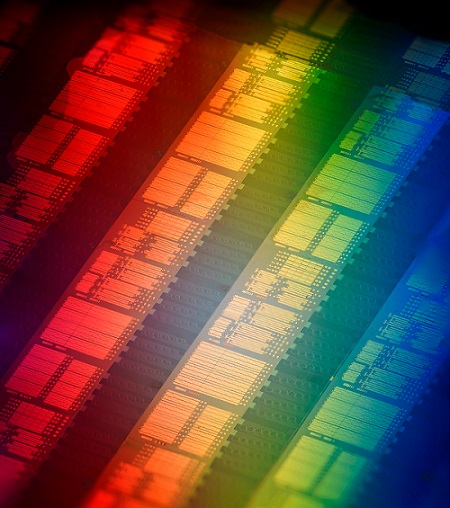A collaboration between John Bowers from the University of California, Santa Barbara (UCSB) and Tobias J. Kippenberg from École Polytechnique Fédérale de Lausanne (EPFL) has yielded an integrated on-chip semiconductor laser and resonator capable of producing a laser microcomb. The breakthrough builds on and upscales technology to support applications in optical communications, ultrafast lidar, neuromorphic computing, and the calibration of astrophysical spectrometers.
The collaboration has been ongoing for several years. In the last decade, the Kippenberg group discovered soliton microcombs, which are chip-scale, optical frequency combs that emit mutually coherent laser lines — that is, lines that are in constant, unchanging phase relative to each other — and also consume low power and exhibit broad bandwidth. Each of the lines of the laser comb can carry information, extensively multiplying the amount of data that can be sent by a single laser.
Though several other teams have recently demonstrated very compact combs by placing a semiconductor laser chip and a separate silicon nitride ring-resonator chip very close together, the laser and the resonator in those works were still separate devices, made independently and then placed in close proximity to each other perfectly aligned. The process to do so is costly and time-consuming. It is also not scalable.

Photograph showing hundreds of semiconductor lasers and silicon nitride microresonators. Courtesy of Chao Xiang, UCSB.
Further, while microcombs are generated on-chip via parametric frequency conversion (two photons of one frequency are annihilated, and a pair of two new photons are generated at a higher and lower frequency), the pump lasers are typically off-chip and bulky. Integrating microcombs and lasers on the same chip can enable high-volume production of soliton microcombs using well-established CMOS techniques developed for silicon photonics.
Achieving this type of an integrated device has been an outstanding challenge for the last decade. The challenge is that the semiconductor laser and the resonator, which generates the comb, must be built on different material platforms. The lasers can only be made with materials from the III and V groups on the periodic table, such as indium phosphide, and the best combs can only be made from silicon nitride.
“We had to find a way to put them together on a single wafer,” said Chao Xiang, a postdoctoral researcher in Bowers’ lab at UCSB who was lead author of a paper describing the advancement.
Working sequentially on the same wafer, the researchers leveraged UCSB’s heterogeneous integration process for making high-performance lasers on silicon substrate. The EPFL collaborators made record ultralow-loss high-Q silicon nitride microresonators using the “photonic damascene process” that they developed. The wafer-scale process, in contrast to making individual devices and then combining them one by one, enables thousands of devices to be made from a single 100-mm-diameter wafer, a production level that can then be scaled up further from the industry standard 200- or 300-mm-diameter substrate.
“Our heterogenous fabrication technology combines the three mainstream integrated photonics platforms, namely silicon, indium phosphate, and Si3N4, and can pave the way for large-volume, low-cost manufacturing of chip-based frequency combs for next-generation high-capacity transceivers, data centers, sensing, and metrology,” said Junqiu Liu, who leads the Si3N4 fabrication at EPFL’s Center of MicroNanoTechnology (CMi).

For the produced device to function properly, the laser, the resonator, and the optical phase between them must be controlled to create a coupled system based on the “self-injection locking” phenomenon. Xiang explained that the laser output is partially back-reflected by the microresonator.
When a certain phase condition is achieved between the light from the laser and the back-reflected light from the resonator, the laser is said to be locked to the resonator.
In a laser microcomb, Xiang said, a distributed feedback laser produces one laser line. That line then passes through an optical phase controller and enters the micro-ring resonator, causing the power intensity to increase as the light travels around the ring. If the intensity reaches a certain threshold, nonlinear optical effects occur and cause the one laser line to create two additional, identical lines on either side. Each of those two “side lines” creates others, leading to a cascade of laser-line generation.
“You end up with a series of mutually coherent frequency combs,” Xiang said, and a vastly expanded ability to transmit data.
Normally, back-reflected light harms laser performance; in the current research it is crucial for generating the microcomb. The locked laser light triggers soliton formation in the resonator and reduces the laser light noise, or frequency instability, at the same time. As a result, the team was able to create not only the first laser soliton microcomb integrated on a single chip, but also the first narrow-linewidth laser sources with multiple available channels on one chip.
“The field of optical comb generation is very exciting and moving very fast. It is finding applications in optical clocks, high-capacity optical networks, and many spectroscopic applications,” said Bowers, the Fred Kavli Chair in Nanotechnology and the director of the College of Engineering’s Institute for Energy Efficiency. “The missing element has been a self-contained chip that includes both the pump laser and the optical resonator. We demonstrated that key element, which should open up rapid adoption of this technology.”
Specifically, the research enables semiconductor lasers to be seamlessly integrated with low-loss nonlinear optical microresonators — “low-loss” because the light can travel in the waveguide without losing a significant amount of its intensity over distance. No optical coupling is required, and the device is entirely electrically controlled.
“Our approach paves the way for large-volume, low-cost manufacturing of chip-based frequency combs for next-generation high-capacity transceivers, data centers, space, and mobile platforms,” the researchers said.
The current comb produces about 20 to 30 usable comb lines.
The research was published in Science (www.doi.org/10.1126/science.abh2076).